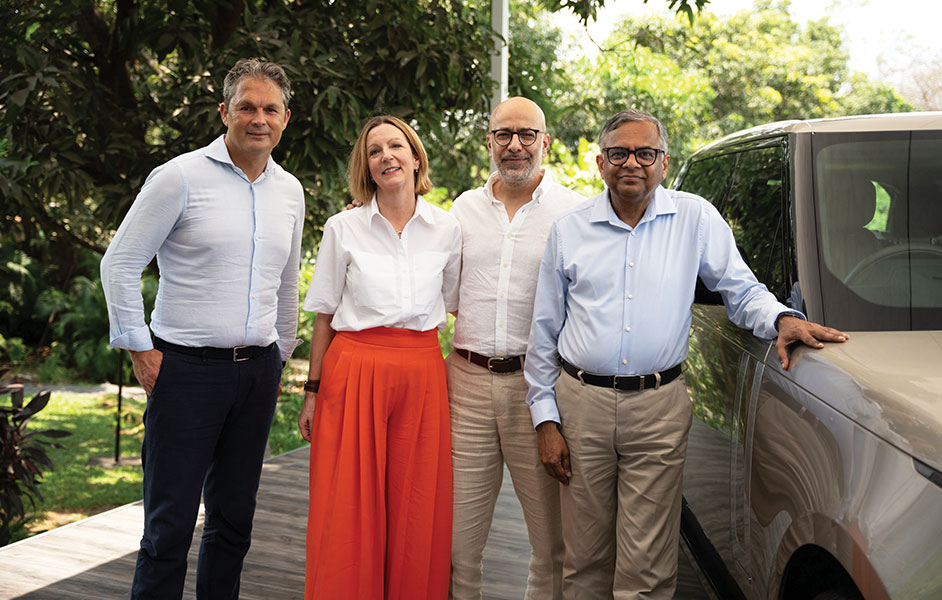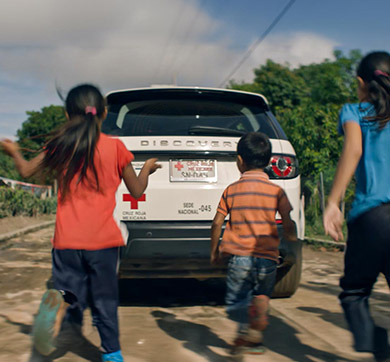November 2024 | 1612 words | 6-minute read
In May 2024, the sleepy little coastal town of Alibaug in Maharashtra was the centre of attention as Range Rover House made an appearance for the first time on Indian shores. Since 2022, over 40 Range Rover Houses have run across 20+ countries in the world’s most desirable locations, from Sydney’s sparkling harbour to Abu Dhabi’s white sandy beaches, to the dazzling glamour of the French Riviera, and now, a luxury villa in Alibaug on the lush Konkan coast.
The grand debut of the Indian Range Rover House was significant for more than one reason. At the idyllic getaway, the leadership team — N Chandrasekaran, Chairman, Tata Sons; Rajan Amba, Managing Director, JLR India; Geraldine Ingham, Managing Director, Range Rover, and Lennard Hoornik, Chief Commercial Officer, JLR — gathered to announce a very special milestone: Range Rover and Range Rover Sport would now be locally manufactured in India. This is the first time in the brand’s 54-year history that its flagship luxury sports utility vehicles will be produced outside its Solihull plant in the UK, from where it has, so far, been exporting to 121 global markets, including India.
This strategy comes in the wake of a surge in sales in India — 160% for Range Rover and 70% for Range Rover Sport — in FY24. “Across the globe, we are seeing the highest levels of client demand for Range Rover in our 54-year history,” said Ms Ingham at the event. “India is a very important part of this success story.” Indeed, 80% of the company’s India order book comprises Range Rover, Range Rover Sport and Defender.

The India opportunity
This isn’t the first time JLR is manufacturing in India — it has been manufacturing its Evoque, Velar, Discover Sport and Jaguar F-Pace models in the country since 2011 — but it is a first for Range Rover’s two flagship models. “The Indian market has exhibited several promising indicators that led us to bring Range Rover production to the country,” says Mr Amba. “Over the last three years we have seen a 3X growth in the JLR India business, and over the next three years we expect to double the business from here. The local manufacturing of our flagship models, Range Rover and Range Rover Sport, is a significant lever to unlock this potential and ambition.”
In FY24, JLR reported ₹4,000 crore in revenue from the Indian market, with total sales at 4,500 units, and 31% year-on-year growth in the first quarter of FY25. “The country’s strong economic growth has resulted in increased purchasing power,” says Mr Amba. “With a GDP growth between 7% to 8% over the last few years, India is targeted to be the third largest economy over the next five years. Another promising indicator is the growing HNI population, leading to a significant surge in demand for luxury goods, which is estimated to reach 1.5 million in the next five years.” According to a Knight Frank report, India’s HNI population, with asset value of $1 million+, is expected to increase from 7.9 lakh (2022) to 16.5 lakh by 2027 — a 107% increase.
Manufacturing excellence
The JLR factory in Pune, Maharashtra, now manufactures six models — Range Rover Velar, Range Rover Evoque, Discovery Sport, Jaguar F-Pace, Range Rover and Range Rover Sport — across two manufacturing lines with a total capacity of 10,000 annually over two shifts. The plant, which operates under a contract manufacturing agreement with Tata Motors Passenger Vehicles, has a dedicated facility both for engine and vehicle manufacturing and has been designed and set up as per JLR’s global manufacturing operating processes. In fact, the plant reports to the Operations Director of the Solihull plant in the UK — the company’s flagship plant and the home of Range Rover and Range Rover Sport. Additionally, JLR next-gen vehicles will also be produced at Tata Motors’ ₹9,000 crore greenfield manufacturing plant in Tamil Nadu.
“There is a huge opportunity for growth in the luxury car market share from the current 1% (and 50,000 units per year) of the total passenger vehicle industry, with the likelihood of it doubling in the next five years with rising wealth and aspirations of the new age Indian consumer,” says Mr Amba. “We have the potential to capture a significant share of the growing luxury market on the back of strong brand equity and a world-class product portfolio in India as visible in recent sales trends. By manufacturing in India, we are well-positioned to capitalise on these trends and strengthen our market presence. Deliveries for these two models have already started. The Range Rover rolled off the line in mid-May and the Range Rover Sport in mid-August.”

Localised advantage
With local production, the car maker aims to reduce lead times and offer Indian clients, who have demonstrated an appetite for luxurious SUVs, the benefit of shorter wait times for its flagship models — there’s currently a 12-month waiting period. The move to local manufacturing at the Tata Motors plant in Pune also translates to lower import duty — a benefit that the company is passing on to its clients and dealers. The prices of Range Rover and Range Rover Sport have reduced by 18% to 22% (while still sitting in the Rs 1.4 crore and above category), making them more competitive post-local manufacturing, helping expand market potential and bringing more buyers into the JLR fold.
“We expect a more positive impact on the bottom line by virtue of the increasing volumes, both for our partners and the enterprise, as a result of the pricing reset coming out of localisation,” says Mr Amba. “This volume increase in our order books has been instantly visible since we announced local manufacturing of our flagship brands at the Range Rover House in May. We have the skill set and experience with our Tata Motors partnership, and the capacity and the support of the larger organisation to leverage the growing demand and potential.” The car maker is present in 21 cities across India and is working to expand its presence by adding two new showrooms every year.

A growing market
“Our plan is to double our business in India over the next three years,” says Mr Amba. “Our modern luxury journey provides a highly aspirational and differentiated positioning for our brands and we expect the luxury car market, especially upwards of `1 crore, to grow in double digits — JLR will lead the market in this growth.”
The car maker plans to achieve this using a fourfold strategy: investing in strengthening brand desire and client experiences, in both sales and after sales; bringing its latest and most innovative products to India in real time, whether it is bespoke and SV or even the Defender Octa and limited editions exclusively for India; a calibrated expansion of its network; and by leveraging synergies that exist within the Tata ecosystem.
Elevating modern luxury experiences
JLR’s endeavour to offer its customers highly curated, bespoke and engaging experiences is a key part of its strategy to build strong brand equity. Range Rover House is one such concept. It is a physical embodiment of the brand — luxurious, modernist and relevant — while also reflecting local and cultural trends and events.
Designed by Gerry McGovern, Chief Creative Officer, JLR, India’s first Range Rover House was located in a luxury villa nestled amidst Alibaug’s lush landscape and showcased the locally manufactured Range Rover and Range Rover Sport. The overall experience offered customers a bespoke journey, wherein each touchpoint — from their journey to the venue via a private luxury yacht to their experiences at Range Rover House itself — was designed to help them explore the brand’s modern luxury vision in a manner that transcended the traditional showroom exchange.
The company also organises Modern Luxury Culinary Experiences as part of its expression of ‘customer love’. Last year, there were five such experiences for Indian customers, across Mumbai, Bengaluru, Delhi and Chandigarh. Another popular initiative is Defender Journeys. These are self-drive, immersive, luxury travel expeditions, across some of the most scenic routes around the country. JLR has organised 36 Defender Journeys, delivering 400 experiences till date, including the Thar Desert Journey in the west, Himalayan Journey in the north, Druk Yul Journey in the north-east and Konkan Journey in the south. There are seven more expeditions planned until March 2025.
“We are witnessing growing demand for SVs and bespoke models and will soon be introducing our bespoke Range Rover SV edition made for India,” says Mr Amba. “We will also be bringing six EVs to India over the next four years, starting with the Range Rover BEV in FY26, for which we already have 400 expressions of interest. We are working with Tata Motors and Tata Power to leverage their strength and expertise in EV charging infrastructure in anticipation of the launch. India’s EV luxury car market is currently in its nascent stage. However, it is poised for substantial growth and expected to grow from the current 4-5% to 40-50% by the end of the decade.”

JLR’s strategic shift to locally manufacture Range Rover and Range Rover Sport in India is set to accelerate the brand’s growth in the country. Its focus on offering its clients value and bespoke experiences has put it in the fast lane towards its mission of surpassing luxury market growth in FY25.
—Anuradha Anupkumar































